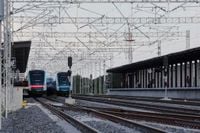On August 19, 2025, the Maya Train—a centerpiece of Mexico’s tourism ambitions and a symbol of modern infrastructure in the Yucatan Peninsula—suffered its second derailment in less than two years. As the train was slowly pulling into the station in Izamal, a small city known for its golden-yellow buildings and rich Maya heritage, one of its cars left the tracks. According to the Associated Press, the train was en route from the bustling Caribbean resort of Cancun to the historic capital of Merida when the incident occurred.
Thankfully, there were no injuries reported. Passengers, some of whom had been eagerly anticipating scenic views of the peninsula’s lush forests and ancient ruins, were instead transported the rest of the way by bus. The train line, in a statement released shortly after the incident, assured the public that the accident was under investigation but stressed that service continued as normal between other stations as of August 20.
Photos and videos that quickly circulated online painted a dramatic—if not catastrophic—picture: one car sat awkwardly off the tracks, leaning but not overturned. The images raised immediate questions about safety and reliability. A federal official, speaking anonymously to the Associated Press because they were not authorized to comment publicly, clarified that part of the derailed car had leaned onto a train on a parallel track. However, there was no collision. The official’s account helped quell some initial fears of a larger disaster, but the optics were hard to ignore.
The Maya Train, or "Tren Maya" as it’s known locally, was conceived as an ambitious legacy project by former President Andrés Manuel López Obrador. Launched in late 2023, it was designed to stretch an impressive 950 miles—about 1,500 kilometers—across the Yucatan Peninsula. The vision was grand: connect the region’s major cities, boost local economies, and provide tourists with a new way to explore the famed Mayan archaeological sites scattered across the landscape. López Obrador envisioned a steady stream of travelers departing from Cancun, journeying through jungles and past pyramids, and discovering the wonders of the peninsula from the comfort of a modern train.
Yet, the reality has been far more complicated. Despite the fanfare and hopes for a tourism boom, actual ridership has been disappointingly low. According to the Associated Press, most passengers have only used the Maya Train for short stretches—primarily between Merida and Cancun—rather than completing the full route. The promise of a transformative travel experience hasn’t quite materialized, leaving some to question the project’s viability and long-term impact.
Complicating matters further, this latest derailment is not the first. In March 2024, the Maya Train experienced another incident at the Tixkokob station in Yucatán. As the train passed a switch entering the station, one car derailed. Fortunately, as with the more recent event, there were no injuries reported. But two derailments in such a short period have inevitably cast a shadow over the project’s safety record and operational procedures.
The derailments have also reignited debates about the project’s origins and the speed with which it was pushed through. Critics have long argued that López Obrador forced the Maya Train forward before essential environmental impact and feasibility studies were completed. Environmentalists, in particular, have sounded the alarm over the train’s route, which cuts through delicate cave systems lying just beneath the surface of the Yucatan. These caves are not just geological curiosities; they provide much of the region’s drinking water. According to the Associated Press, environmentalists have documented severe impacts to these systems, raising concerns about water security and long-term ecological damage.
Supporters of the Maya Train, however, maintain that the project is a much-needed investment in the region’s infrastructure and a catalyst for economic development. They argue that the Yucatan Peninsula, with its world-renowned archaeological sites and natural beauty, deserves better connectivity and new opportunities for local communities. For them, the train represents progress and the promise of a brighter future.
But for many residents and environmental advocates, the risks have always seemed to outweigh the rewards. The environmental impacts documented include not only threats to water supplies but also potential harm to the unique flora and fauna that inhabit the peninsula’s forests and caves. The Associated Press reports that these concerns were largely brushed aside in the rush to start construction and meet political deadlines.
As the Maya Train continues to operate—albeit with a blemished safety record—questions linger about how such incidents will affect public confidence and the project’s reputation. Will tourists feel safe boarding a train that has now derailed twice within two years? Will the government take steps to address the environmental and safety concerns raised by both experts and the public? These are the pressing questions facing the operators and policymakers behind the Maya Train.
The derailment in Izamal has also prompted discussions about the broader challenges of large-scale infrastructure projects in Mexico and beyond. The push to complete ambitious projects quickly, often in the face of logistical, environmental, and social hurdles, is not unique to the Maya Train. Around the world, governments and private developers frequently wrestle with the delicate balance between development and preservation, speed and safety.
For tourists who had hoped for a seamless journey through the heart of the Yucatan, the experience was certainly less than ideal. Yet, the absence of injuries in both derailments is a small relief, and the swift response in transporting passengers by bus ensured that travel plans, while disrupted, were not entirely derailed themselves.
As investigations continue into the cause of the latest incident, the operators of the Maya Train will be under pressure to demonstrate that lessons have been learned and that future journeys will be safer. Meanwhile, the debate over the train’s environmental footprint and its role in shaping the future of the Yucatan Peninsula is far from over.
The Maya Train’s journey has been anything but smooth. Its story, marked by high hopes, real risks, and ongoing controversy, is still being written. For now, the tracks are clear between most stations, but the path ahead remains uncertain.




